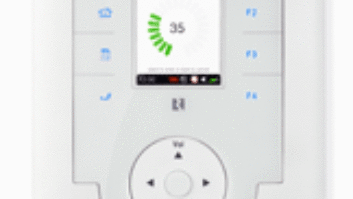As new construction starts remain lackluster, the battle cries amongst the installer ranks have become, “Return to retrofit!” However, this is often easier said than done. Russound’s brandnew audio distribution system is tailor-made for the retrofit market.

The system, called Collage, distributes signals throughout the home over existing power lines, meaning that virtually every home is a candidate. It consists of Collage Amplified Keypads (CAK1, $849) and the Collage Media Manager (CMM1, $549). The CMM1 supports up to 10 CAK1s and delivers up to three separate audio streams, either from Rhapsody or files (MP3, WMA, AAC, WAV) stored on a networked drive.
1. THE INSTALL
After unboxing the CAK1, I thought, “There’s no way this will fit inside a wall.” But, at 3.82 inches deep, it just fits in standard 2 x 4 walls with half-inch drywall.
Following a quick process where keypads are named and “bound” to the CMM1, each component is taken to the area where you are planning to install it. Because signals are transmitted over power line, logical locations are above light switches or electrical outlets. (Russound recommends mounting the center of the screen 59 inches above the floor.)

For the install in my 12-year old, 2,000-squarefoot home, I placed the CMM1 next to my router, with controllers in my dining room, living room, master bedroom, and master bathroom. The bathroom pad and the CMM1 were located as far apart as is possible in my home.
Once all devices are connected, the system checks and reports the signal strength of every device, called Gridcast Status. Collage uses Home- Plug 1.0+ Extended technology, and in my install every device reported a perfect 10. (Russound recommends at least a 6.)
Because installation requires connecting to high voltage, it must be installed by a licensed and qualified electrician, which will likely mean subbing this portion out. The actual backbox, power supply, power pocket, and keypad are really a design marvel, and once power connections have been made, they install quite easily into the wall.
Speakers wire directly to the CAK1 with up to 14-gauge wire and any type can be used. Russound offers a nice complement in the form of the Acclaim 7W51SFT, which is a single, stereo, square in-wall that could easily install directly above the CAK1.
2. THE PERFORMANCE
Once everything was installed and the firmware updated, I activated Rhapsody and started listening. Keypad control is very intuitive, and could be explained to, and understood by, a new user in moments. Further, while the text is small, I found the screen easy to read.
The amplifier won’t be mistaken for audiophile quality, but it was certainly potent enough to drive my speakers to “rock on!” listening levels without distorting. I drove several different types from my pre-existing Sonance in-ceiling models, to some PSB bookshelves to an Acclaim 7W51SFT. Volume had a very usable range, and I generally listened at levels of 25 to 55 (out of 100). I really liked using the five-band EQ to finetune the sound to each room or speaker type, boosting, or trimming frequencies as desired.
The intercom offers point-to-point, wholehouse, and room monitoring options, and is a terrific value add-on.
3. THE VERDICT
Without question, Collage is a far easier path to retrofitting audio into a home, and a crew banging out a 10-room install in a single day is no stretch. Also, Gridcast performance, which was a perfect 10 in my home, indicates that the system should perform admirably in the real world. Additionally, Russound plans on-going upgrades to the Collage line-up, including new features and enhancements via firmware, an iPod dock, and a source bridge to connect legacy (CD, cable, satellite, etc.) sources or a composite CCTV camera for video images. With this in mind, recommending Collage as a way to tap into the potentially lucrative retro market is a no-brainer.


